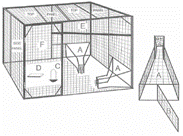Eastern Wildlife Damage Control Conferences

Eastern Wildlife Damage Management Conference: 8th (1997)
Date of this Version
October 1997
Document Type
Article
Abstract
Wildlife managers in the State of Virginia developed an integrated Canada goose (Branta Canadensis) damage management program in 1996 to address increasing damage caused by resident (non-migratory) Canada geese, primarily in urban/suburban areas. The previous Canada goose damage management program relied primarily on harassment and relocation. The integrated program was made available to citizens, homeowner associations, businesses, organizations, city and county governments, and state and federal agencies in 1997. The Integrated Canada Goose Management Program was developed by U.S. Department of Agriculture-Animal and Plant Health Inspection Service-Wildlife Services, Virginia Department of Agriculture and Consumer Services, Virginia Department of Game and Inland Fisheries, and the U.S. Fish and Wildlife Service. An aggregate of environmental, hunting, animal welfare, and agriculture groups, airports, golf courses, utilities, homeowner associations, federal agencies, and state and county government attended a focus group meeting and commented on the integrated Canada goose damage management plan. The plan implemented biological control, habitat alteration, harassment, exclusion, husbandry, repellents, and population management strategies. A new method, capture and euthanasia, was made available under the population management strategy. Capture and euthanasia was made available because other population management methods (i.e., hunting) were unavailable in some urban/suburban areas, relocation of resident Canada geese was unrealistic because resident Canada geese were a problem statewide, and resident Canada goose populations numbered >200,000 birds in 1996 and were growing 10-15% annually statewide. Canada geese captured in urban/suburban areas in 1997 (n=1,548) were brought alive to meat processors for processing and packaging. Hunters for the Hungry, a statewide charity, distributed processed Canada goose meat to local food banks. The entity requesting capture and euthanasia services under this program reimbursed USDA for services received.


Comments
Published in Proceedings of the Eighth Eastern Wildlife Damage Management Conference, Roanoke, Virginia, October 16–19, 1997, edited by James A. Parkhurst. Copyright © 1997 by the authors.